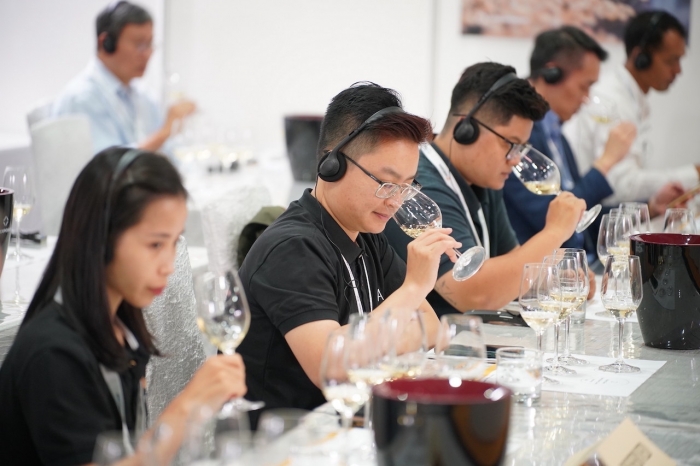10,000+ Trade Visitors from 60 Countries Converge on Vinexpo Asia 2024
China's Wine and Spirits Market Projected to Grow 19% by 2027
2024-05-30

Vinexpo Asia 2024 returned to Hong Kong this May after its debut in Singapore last year. Over three days, from May 28th to 30th, the event drew more than 10,000 trade visitors from 60 countries, showcasing 1,032 wine and spirits producers from 35 countries at the bustling Hong Kong Convention and Exhibition Centre (HKCEC).
Key discussions at the event centered around several pivotal themes, notably the rise of baijiu, the focus on the Chinese market, and the influence of Hong Kong as a trading hub.
The Dominance of Baijiu
A highlight of Vinexpo Asia was a session titled "Status Spirits: Perpetual Progress or Bubble About to Burst?" led by Luke Tegner, Director of Consultancy at IWSR Drinks Market Analysis. This session delved into the super-premium spirits sector, defined by IWSR as spirits priced above $100. Despite being a niche market, the significance of these high-value spirits has grown substantially.
From 2017 to 2022, the market share for these premium spirits nearly doubled from 8% to 15% globally. Baijiu, a Chinese liquor, commands a staggering 85% of this segment, valued at $212 billion. While sales volume for lower-priced baijiu is declining, the super-premium category is thriving, achieving extraordinary prices. Tegner emphasized this, highlighting baijiu's remarkable market performance despite being largely confined to China.
However, there's uncertainty about baijiu's appeal to younger consumers, who are less drawn to cheaper options. Major brands are increasingly leveraging digital platforms to engage this demographic. For instance, Luckin Coffee sold coffee infused with Kweichow Moutai baijiu worth 100 million yuan (around $10.9 million) in a single day.
Strong sales in high-price segments should bolster baijiu's presence in other markets, such as duty-free shops. Besides baijiu, other status spirits like whisky are seeing significant demand across Asia, with the region experiencing the highest global growth in this category.
China in Focus
Before the event, Rodolphe Lameyse, CEO of Vinexposium, stressed that China is now the main focus for the Hong Kong exhibition. Meanwhile, the biennial Singapore fair caters more to Southeast Asian markets. This year's novelty was reconnecting with the Chinese market. Asia, and particularly China, is a crucial market for the industry, with IWSR predicting a 19% growth in wines and spirits by 2027.
Don St Pierre, co-founder of ASC Fine Wines and AdaptEdge, countered the narrative that China is losing relevance. Hong Kong, acting as a gateway to the Greater Bay Area (GBA) with its 87 million population, remains pivotal. The GBA is China's fastest-growing region, boasting the country's youngest and best-educated demographic.
The Influence of Hong Kong
Philippe Chan, General Manager of YouGov Greater China, believes Hong Kong uniquely positions itself to drive development in the GBA market. Jaime Martin Chocano, Managing Director for North Asia at Edrington, noted that Hong Kong and Macau's luxury purchase influence makes them ideal investment locations in China. The lack of tariffs on wine maintains Hong Kong's market relevance, with a significant portion of imported wine being re-exported to other Asian markets.
Mattieu Thibaut, General Manager of Corney and Barrow, echoed this sentiment, emphasizing Hong Kong's accessibility to China and reinforcing its status as a vital hub for wine and spirits.
Australian Presence
Given China's importance, the presence of Australian exhibitors at Vinexpo Asia was expected. Tariffs on Australian wine in China were lifted on March 29th, prompting many producers to register for the Hong Kong fair. Major players like Yalumba attended, primarily to meet their importer, ASC Fine Wines, in person for the first time in years. However, not all were China-focused. Handpicked Wines from Tasmania aimed to build relationships with importers in South Korea and Japan, meeting distributors from Thailand and other Southeast Asian markets, indicating the fair's broader appeal beyond just China.
French Representation
Unsurprisingly, Vinexposium ensured a strong French presence, with French exhibitors making up a third of the total. France is a major supplier of imported wine in China by volume, making Hong Kong a critical trade hub between the two countries.
French Ambassador to China, Bertrand Lortholary, attended the opening ceremony, highlighting wine's power to build bridges. However, the future is uncertain with rumors that China might target EU wine exports following EU anti-subsidy investigations into Chinese companies. This could jeopardize the $800 million wine trade between the EU and China, affecting top exporters like France, Italy, Spain, Germany, and Portugal, with France responsible for nearly half of these exports.
Despite these challenges, 2024 being the official year of tourism between France and China underscores the ongoing significance of Hong Kong as a crucial step in the trade pathway between the two nations, a sentiment echoed throughout Vinexpo Asia 2024.
Founded in 2007, Vinetur® is a registered trademark of VGSC S.L. with a long history in the wine industry.
VGSC, S.L. with VAT number B70255591 is a spanish company legally registered in the Commercial Register of the city of Santiago de Compostela, with registration number: Bulletin 181, Reference 356049 in Volume 13, Page 107, Section 6, Sheet 45028, Entry 2.
Email: [email protected]
Headquarters and offices located in Vilagarcia de Arousa, Spain.